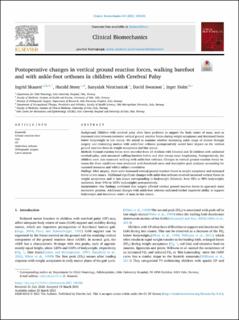| dc.contributor.author | Skaaret, Ingrid | |
| dc.contributor.author | Steen, Harald | |
| dc.contributor.author | Niratisairak, Sanyalak | |
| dc.contributor.author | Swanson, David Michael | |
| dc.contributor.author | Holm, Inger | |
| dc.date.accessioned | 2022-02-10T06:47:36Z | |
| dc.date.available | 2022-02-10T06:47:36Z | |
| dc.date.created | 2021-10-22T08:56:14Z | |
| dc.date.issued | 2021 | |
| dc.identifier.citation | Clinical Biomechanics. 2021, 84 1-8. | en_US |
| dc.identifier.issn | 0268-0033 | |
| dc.identifier.uri | https://hdl.handle.net/11250/2978104 | |
| dc.description.abstract | Background: Children with cerebral palsy often have problems to support the body centre of mass, seen as increased ratio between excessive vertical ground reaction forces during weight acceptance and decreased forces below bodyweight in late stance. We aimed to examine whether increasing ankle range of motion through surgery and restraining motion with ankle-foot orthoses postoperatively would have impact on the vertical ground reaction force in weight acceptance and late stance. Methods: Ground reaction forces were recorded from 24 children with bilateral and 32 children with unilateral cerebral palsy, each measured walking barefoot before and after triceps surae lengthening. Postoperatively, the children were also measured walking with ankle-foot orthoses. Changes in vertical ground reaction forces between the three conditions were evaluated with functional curve and descriptive peak analyses; accounting for repeated measures and within-subject correlation. Findings: After surgery, there were decreased vertical ground reaction forces in weight acceptance and increased forces in late stance. Additional significant changes with ankle-foot orthoses involved increased vertical forces in weight acceptance, and in late stance corresponding to bodyweight (bilateral, from 92% to 98% bodyweight; unilateral, from 94% to 103% bodyweight) postoperatively. Interpretation: Our findings confirmed that surgery affected vertical ground reaction forces to approach more normative patterns. Additional changes with ankle-foot orthoses indicated further improved ability to support bodyweight and decelerate centre of mass in late stance. | en_US |
| dc.language.iso | eng | en_US |
| dc.publisher | Elsevier | en_US |
| dc.rights | Navngivelse 4.0 Internasjonal | * |
| dc.rights.uri | http://creativecommons.org/licenses/by/4.0/deed.no | * |
| dc.subject | Ground reaction force | en_US |
| dc.subject | Ankle-foot orthoses | en_US |
| dc.subject | Orthopaedic surgery | en_US |
| dc.title | Postoperative changes in vertical ground reaction forces, walking barefoot and with ankle-foot orthoses in children with Cerebral Palsy | en_US |
| dc.type | Peer reviewed | en_US |
| dc.type | Journal article | en_US |
| dc.description.version | publishedVersion | en_US |
| cristin.ispublished | true | |
| cristin.fulltext | original | |
| cristin.qualitycode | 1 | |
| dc.identifier.doi | 10.1016/j.clinbiomech.2021.105336 | |
| dc.identifier.cristin | 1947744 | |
| dc.source.journal | Clinical Biomechanics | en_US |
| dc.source.volume | 84 | en_US |
| dc.source.pagenumber | 1-8 | en_US |
| dc.subject.nsi | VDP::Medisinske Fag: 700::Klinisk medisinske fag: 750::Ortopedisk kirurgi: 784 | en_US |

